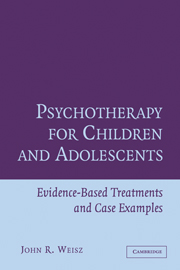Book contents
- Frontmatter
- Contents
- Preface
- SECTION A GENERAL INTRODUCTION
- SECTION B TREATMENTS FOR FEARS AND ANXIETY
- SECTION C TREATMENTS FOR DEPRESSION
- Introduction to Section C: The Case of Megan and Treatments for Depression
- 4 Cognitive-Behavioral Therapies for Child Depression
- 5 Cognitive-Behavioral Therapies for Adolescent Depression
- SECTION D TREATMENTS FOR ATTENTION DEFICIT/HYPERACTIVITY DISORDER
- SECTION E TREATMENTS FOR CONDUCT PROBLEMS AND CONDUCT DISORDER
- SECTION F CONCLUSION
- References
- Author Index
- Subject Index
4 - Cognitive-Behavioral Therapies for Child Depression
Published online by Cambridge University Press: 06 July 2010
- Frontmatter
- Contents
- Preface
- SECTION A GENERAL INTRODUCTION
- SECTION B TREATMENTS FOR FEARS AND ANXIETY
- SECTION C TREATMENTS FOR DEPRESSION
- Introduction to Section C: The Case of Megan and Treatments for Depression
- 4 Cognitive-Behavioral Therapies for Child Depression
- 5 Cognitive-Behavioral Therapies for Adolescent Depression
- SECTION D TREATMENTS FOR ATTENTION DEFICIT/HYPERACTIVITY DISORDER
- SECTION E TREATMENTS FOR CONDUCT PROBLEMS AND CONDUCT DISORDER
- SECTION F CONCLUSION
- References
- Author Index
- Subject Index
Summary
A well-known hallmark of depression is dysphoric mood, sometimes expressed by children as irritability or anger. Beyond the emotional state, depressed children often show characteristic styles of thinking and behaving. On the thinking front, they may interpret events and conditions in unduly negative ways. Compared to their peers, depressed children may see themselves as less able or worthy and their situations as more hopeless. On the behavioral front, depressed children may be more passive than their peers in situations that need to be changed; they may also show skill deficits that undermine school performance and interfere with peer relationships. Child depression then can involve problems in mood and emotion, problems in cognitive style, and problems in behavior and skill development.
Problems of each type are targeted in cognitive-behavioral treatment (CBT), the focus of this chapter. In CBT, therapists work with depressed children to deal with problems of sadness and irritability, partly by focusing on how the children think, and partly by addressing deficits in behavioral skills. One of the best-known CBT approaches for children is the program developed by Kevin Stark and colleagues (see Stark et al., 1987; Stark, 1990), which addresses mood, cognitions, and behavior, and also teaches children to evaluate and reward themselves for doing difficult tasks well. We will devote most of the chapter to a discussion of the Stark et al. approach. In addition, we will review other CBT treatments used for child depression to illustrate the range of specific approaches included within the CBT rubric.
- Type
- Chapter
- Information
- Psychotherapy for Children and AdolescentsEvidence-Based Treatments and Case Examples, pp. 104 - 128Publisher: Cambridge University PressPrint publication year: 2004



